
|
If nothing else, 2020 has been a masterclass for many Americans on how to deal with stress. Whether you're worried about the global health pandemic, the state of our nation, or just the general uncertainty of what comes next, adjusting to this new normal also means managing near-constant feelings of anxiety or worry.
Another aspect of change in 2020 that has taken some getting used to for millions of people across the country is working from home. While not the drain on workplace productivity that many managers anticipated, nixing the daily commute has created an opportunity for more job flexibility for workers, including when they clock in and clock out.
But are these blurred work hours good for employees, or do they continue to further obscure the work-life balance that's been all but erased for many Americans attempting to find harmony between their work and home lives? To find out, we surveyed over 1,000 people about how often they've been taking breaks while working from home, which days tend to be the most flexible, and what employees are finding time for while they're working from home (including working out, reading, or the occasional catnap). The lunch hour may be dead, but many new work-from-home professionals are finding time for other activities instead. Read on to see what we learned.
Before the COVID-19 pandemic began, the average employee took four breaks at work throughout the day, with just 23% of people reporting more than five breaks during their in-office workday. In contrast, those polled indicated taking five breaks from work, on average, since the pandemic began, with 34% of people taking more than five breaks.
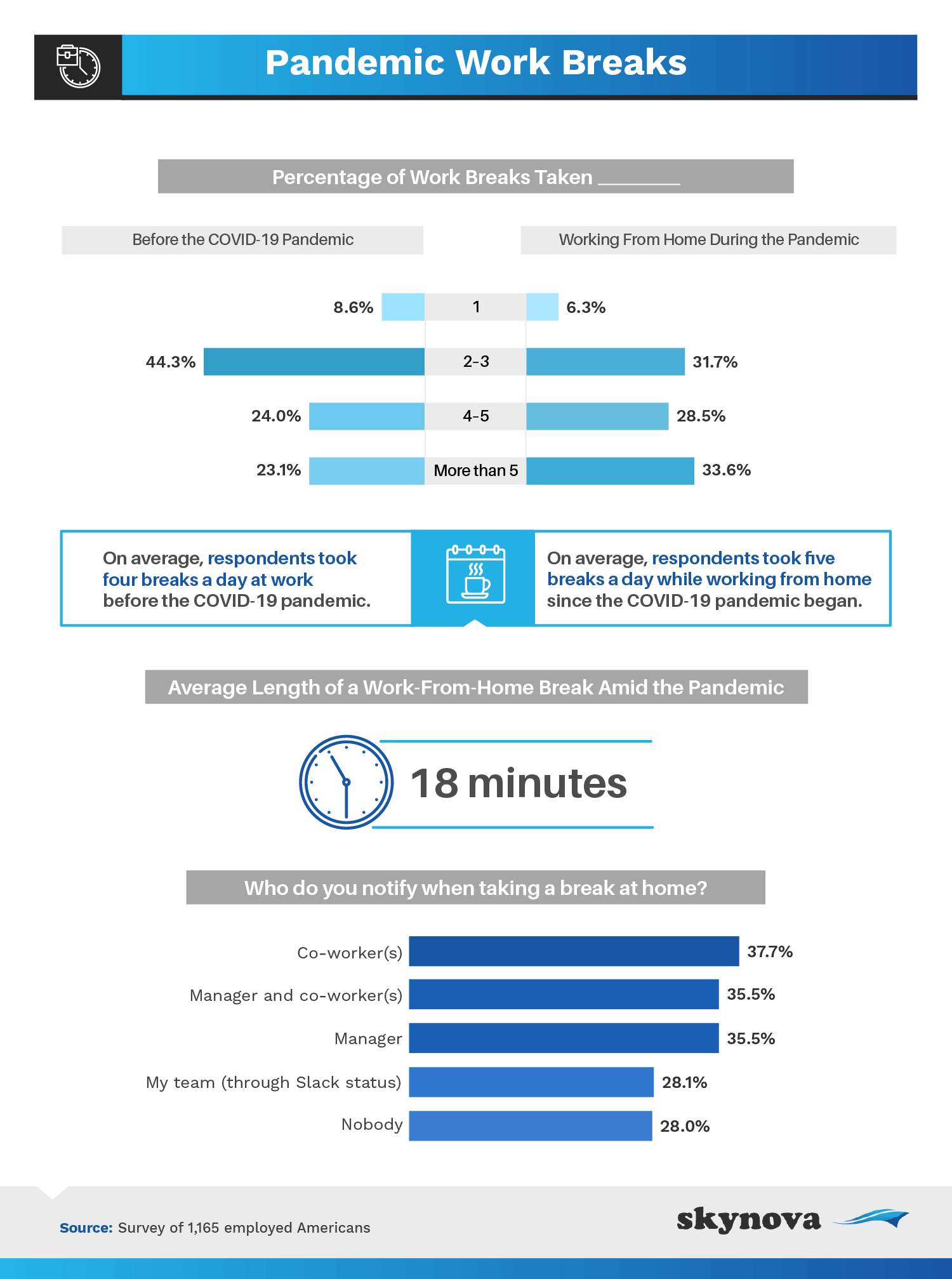
More than a quick trip to the kitchen or for a bio break, the average break taken by people working from home during the pandemic was 18 minutes long. With five breaks on average throughout the day, those intervals add up to 1.5 hours in total. While 28% of employees said they don't notify anyone before stepping away from their workstations, roughly 1 in 3 acknowledged alerting someone they work with first, including their co-workers (38%), manager (36%), or both (36%). Another 28% used the technology at their disposal to communicate when they're away from their keyboard, changing their Slack status rather than messaging their teams directly.
The once standard midday lunch break may be largely extinct, but that doesn't mean you should miss the opportunity to take breaks throughout the workday. While it may seem like shirking your duties, experts say intervals throughout the day can help boost productivity, reduce feelings of stress, increase creativity, and typically lead to healthier habits.
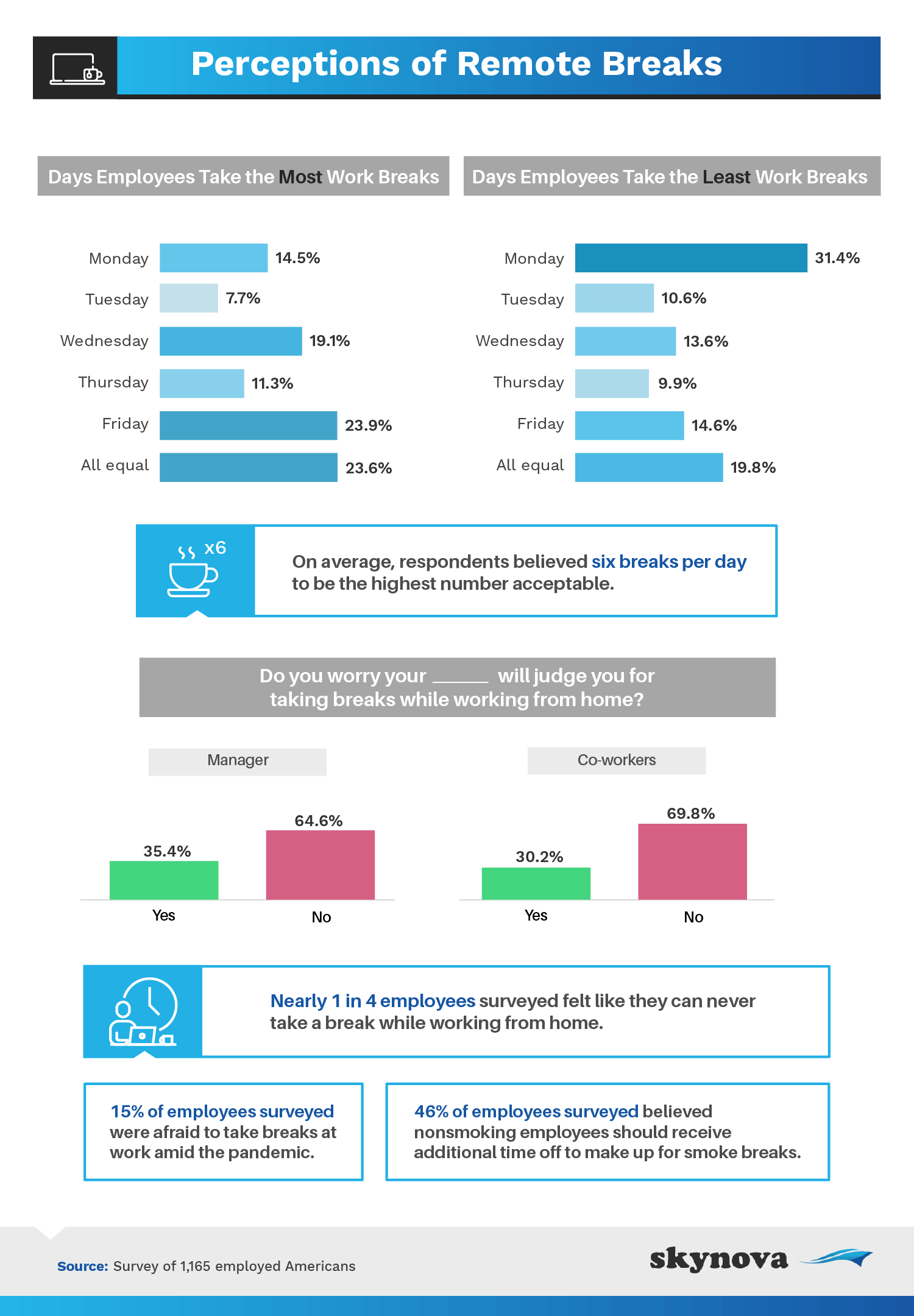
As with most good things, moderation is key. According to those surveyed, an average of six breaks was considered the highest acceptable number of times for someone to step away from their workstation in a day. While 24% of people considered any day of the week an equal opportunity for midday breaks, Fridays (24%) and Wednesdays (19%) were the most popular. When asked which days they were least likely to take breaks while working remotely, Mondays (31%) were overwhelmingly inconvenient.
A majority of people were not worried about either their managers or co-workers judging them for taking regular breaks while working from home, though 35% reported concern that their bosses might criticize them for stepping away. Close to 1 in 4 people indicated they felt they could never take breaks while working remotely.
A vast majority (70%) of people felt encouraged by their boss or job to take breaks while working from home, but completely unplugging may be more difficult. Forty-six percent of employees acknowledged feeling pressured to stay available to their co-workers, even while on a break. More than a third of people (34%) admitted they lied about their breaks while working from home.
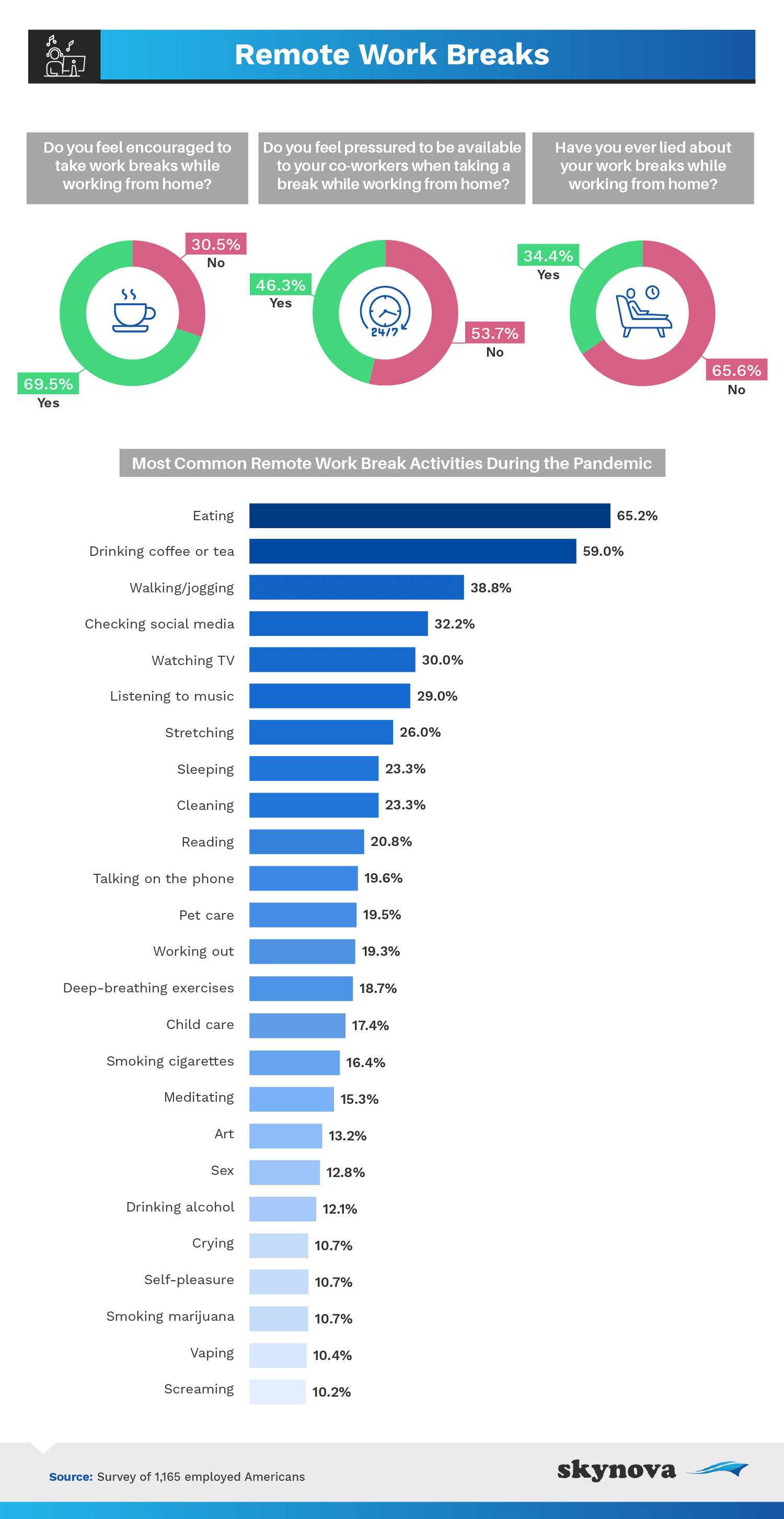
For people adapting to telework, the most common break activities included eating (65%), drinking coffee or tea (59%), going for a walk or jogging (39%), and checking social media (32%). Particularly during the pandemic, with so few normal activities open or available, getting outside for a quick walk or a jog can have numerous emotional benefits. A little fresh air and some sunshine can help boost your productivity when you get back to work and can help you feel more creative at the same time. Thirty percent of people reported watching TV while taking breaks from their remote job, and 23% admitted to taking a nap with their breaks.
One of the most difficult parts of adapting to these new remote work environments is learning how to unplug and disconnect when the day is over. When your work life and your home life coexist in the same space, it can be even more challenging to "turn off" from work at the end of the day.
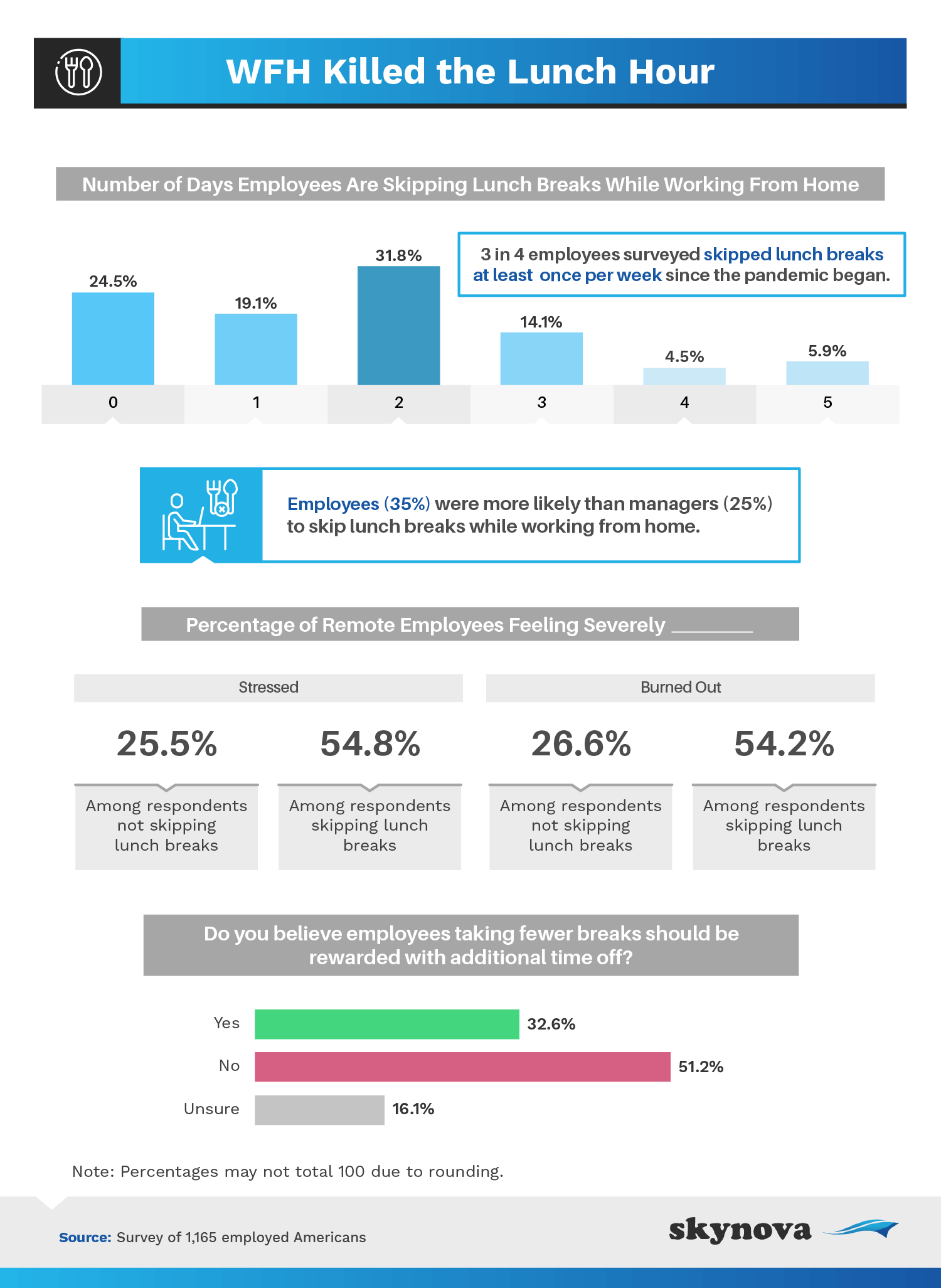
Since the pandemic began, 3 in 4 employees admitted to skipping lunch breaks at least once each week, and employees (35%) were more likely than managers (25%) to skip their lunches while working from home. While 25% of people polled didn't skip lunch breaks at all, 32% acknowledged skipping lunch breaks twice a week, and 14% skipped their lunch hour three times weekly. Despite possibly giving up their lunchtime, 51% of people agreed employees who take fewer breaks throughout the day shouldn't be rewarded with additional time off from work.
For a majority of managers, employees taking breaks while working from home isn't just a nice-to-do. Sixty-six percent of managers mandated their employees to take breaks while working remotely, and another 83% acknowledged encouraging their teams to take breaks while working from home.
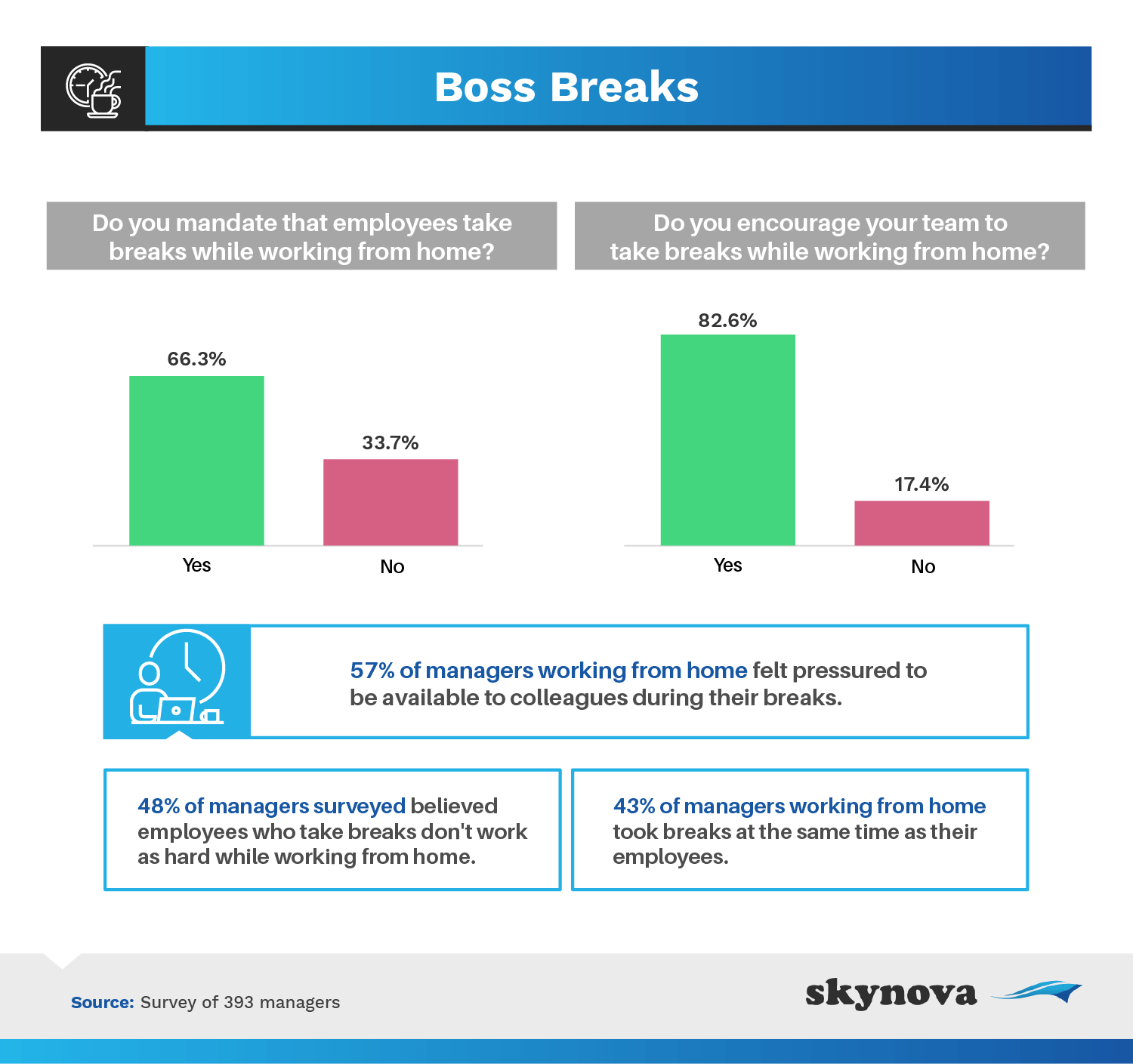
Among the managers polled, 43% indicated they take breaks at the same time their team members do, though 57% felt pressured to be available to their employees during their own breaks. Less than half of managers (48%) believed employees who take breaks aren't working as hard while they're working from home.
Working from home can be a struggle, but many employees are finding more opportunities to take smaller breaks throughout the day. While most people aren't taking a conventional lunch break during the pandemic, a majority of managers are encouraging (even requiring) their teams to take the appropriate amount of time off throughout the day.
In addition to getting something to eat or drink, people are finding spare moments while working from home to do other things, including watching TV, working out, reading, and napping. Instead of taking two or three breaks throughout the workday, most new remote employees are taking five breaks a day (or more) to feel more energized and focused at their jobs.
As we found, people skipping something as simple as a lunch break were twice as likely to report feeling stressed or burnout from work. With the strain of transitioning to working from home, taking time to take a break could be more important than ever before.
We have 37 unique software modules specifically produced and curated to support small businesses with all of their invoicing and accounting needs. These software solutions have been designed to work independently or together based on your business model and pain points. With invoice solutions (including subscription and recurring invoices), accounting support, credit notes, retainers, and more, Skynova helps you keep all of your finances in one place. Learn more online at Skynova.com today.
For this study, we surveyed 1,165 professionals via Amazon Mechanical Turk who are currently working from home about their work breaks. To qualify for the survey, respondents had to indicate that they'd switched working from home at some point since the onset of the COVID-19 pandemic.
Of the 1,165 professionals surveyed, 43.1% were female, 56.7% were male, and less than 1% identified as nonbinary. The average age of respondents was 37 with a standard deviation of 11 years. An attention-check question was used to identify and disqualify respondents who failed to read questions and answers in their entirety.
The main limitation of this study is the reliance on self-report, which is faced with several issues such as, but not limited to, attribution, exaggeration, recency bias, and telescoping. This survey ran during September 2020.
If your readers are adapting to working from home, we encourage you to share the results of this study with them for any noncommercial use. We simply ask that you include a link back to this page in your story so they have access to our full findings and methodology.